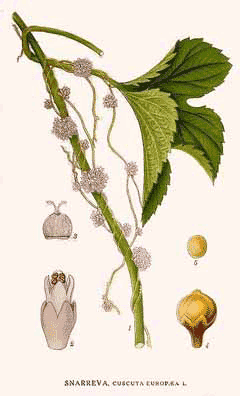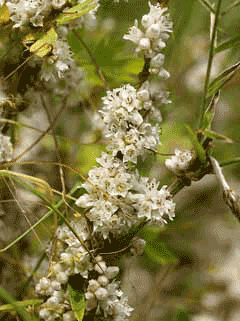 |
|
http://commons.wikimedia.org/wiki/File:106_Cuscuta_europaea.jpg |
 |
| http://commons.wikimedia.org/wiki/User:LycaonCuscuta japonica |
Translate this page:
Summary
Physical Characteristics
![]()
![]() Cuscuta europaea is a ANNUAL. It is in flower from August to September. The species is hermaphrodite (has both male and female organs).
Cuscuta europaea is a ANNUAL. It is in flower from August to September. The species is hermaphrodite (has both male and female organs).
Suitable for: light (sandy), medium (loamy) and heavy (clay) soils. Suitable pH: mildly acid, neutral and basic (mildly alkaline) soils. It can grow in semi-shade (light woodland) or no shade. It prefers moist soil.
UK Hardiness Map
US Hardiness Map
Synonyms
Plant Habitats
Cultivated Beds;
Edible Uses
References More on Edible Uses
Medicinal Uses
Plants For A Future can not take any responsibility for any adverse effects from the use of plants. Always seek advice from a professional before using a plant medicinally.
The entire plant is used in Tibetan medicine, where it is considered to have a bitter, acrid and sweet taste with a heating potency[241]. It is aphrodisiac, renal and a hepatic tonic, being used to increase semen, to treat pain in the wrist and limbs, vaginal/seminal discharge, polyuria, tinnitus and blurred vision[241].
References More on Medicinal Uses
The Bookshop: Edible Plant Books
Our Latest books on Perennial Plants For Food Forests and Permaculture Gardens in paperback or digital formats.

Edible Tropical Plants
Food Forest Plants for Hotter Conditions: 250+ Plants For Tropical Food Forests & Permaculture Gardens.
More

Edible Temperate Plants
Plants for Your Food Forest: 500 Plants for Temperate Food Forests & Permaculture Gardens.
More

More Books
PFAF have eight books available in paperback and digital formats. Browse the shop for more information.
Shop Now
Other Uses
References More on Other Uses
Cultivation details
241 This is a parasitic species that is devoid of leaves, roots or chlorophyll and so is totally dependant upon its host[238]. A climbing plant, it must be grown close to a host plant around which it will twine itself and which it will penetrate with suckers in order to obtain nutriment[238, 245]. It Britain it is found most commonly growing on the roots of stinging nettles (Urtica dioica) and hops (Humulus lupulus)[17], whilst in China it is found mainly on plants in the families Composite, Leguminosae and Chenopodiaceae, though it can also be found on many other herbaceous plants[266].
References Carbon Farming Information and Carbon Sequestration Information
Temperature Converter
Type a value in the Celsius field to convert the value to Fahrenheit:
Fahrenheit:
The PFAF Bookshop
Plants For A Future have a number of books available in paperback and digital form. Book titles include Edible Plants, Edible Perennials, Edible Trees,Edible Shrubs, Woodland Gardening, and Temperate Food Forest Plants. Our new book is Food Forest Plants For Hotter Conditions (Tropical and Sub-Tropical).
Shop Now
Plant Propagation
Other Names
If available other names are mentioned here
European dodder,
greater dodder
French: cuscute d'Europe.
China: ou zhou to si zi.
Czech Republic: kokotice evropska.
Germany: Europäische Seide.
Italy: cuscuta.
Japan: kushironenashikazura.
Netherlands: groot warkruid.
Spain: cabellos de venus.
Sweden: naesselsnaerja.
Native Range
TEMPERATE ASIA: Turkey, Russian Federation-Ciscaucasia (Ciscaucasia), Armenia, Azerbaijan, Georgia, Russian Federation (Dagestan), Russian Federation-Western Siberia (Western Siberia), Russian Federation-Eastern Siberia (Eastern Siberia), Kazakhstan, Kyrgyzstan, Tajikistan, Russian Federation (Primorye, Sakhalin), China (Gansu Sheng, Heilongjiang Sheng, Nei Mongol Zizhiqu, Qinghai Sheng, Shaanxi Sheng, Shanxi Sheng, Sichuan Sheng, Xinjiang Uygur Zizhiqu, Xizang Zizhiqu, Yunnan Sheng) EUROPE: Denmark, Finland, Norway, Czechoslovakia, Austria, Belgium, Switzerland, Germany, Hungary, Netherlands, Poland, Russian Federation (European part), Belarus, Estonia, Lithuania, Latvia, Moldova, Ukraine, Former Yugoslavia, Albania, Bulgaria, Greece, Italy, Romania, Spain, France AFRICA: Algeria
Weed Potential
Right plant wrong place. We are currently updating this section.
Please note that a plant may be invasive in one area but may not in your area so it's worth checking.
Listed as a noxious weed in 13 U.S. States. Not proved to be a highly invasive species, but there are very significant risks of accidental introduction with contaminated crop seed and any such introduction could cause serious crop damage, and prejudice options for trading crop produce.
Conservation Status
IUCN Red List of Threatened Plants Status : This taxon has not yet been assessed.

Growth: S = slow M = medium F = fast. Soil: L = light (sandy) M = medium H = heavy (clay). pH: A = acid N = neutral B = basic (alkaline). Shade: F = full shade S = semi-shade N = no shade. Moisture: D = dry M = Moist We = wet Wa = water.
Now available:
Food Forest Plants for Mediterranean Conditions
350+ Perennial Plants For Mediterranean and Drier Food Forests and Permaculture Gardens.
[Paperback and eBook]
This is the third in Plants For A Future's series of plant guides for food forests tailored to
specific climate zones. Following volumes on temperate and tropical ecosystems, this book focuses
on species suited to Mediterranean conditions—regions with hot, dry summers and cool, wet winters,
often facing the added challenge of climate change.
Read More
Expert comment
Author
L.
Botanical References
17266
Links / References
For a list of references used on this page please go here
Readers comment
| Add a comment |
|
If you have important information about this plant that may help other users please add a comment or link below. Only comments or links that are felt to be directly relevant to a plant will be included. If you think a comment/link or information contained on this page is inaccurate or misleading we would welcome your feedback at [email protected]. If you have questions about a plant please use the Forum on this website as we do not have the resources to answer questions ourselves.
* Please note: the comments by website users are not necessarily those held by PFAF and may give misleading or inaccurate information.
To leave a comment please Register or login here All comments need to be approved so will not appear immediately.
|
Subject : Cuscuta europaea
|
|
|
|